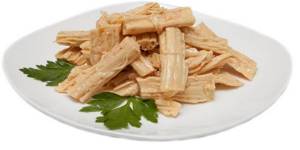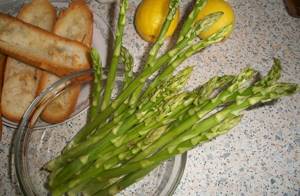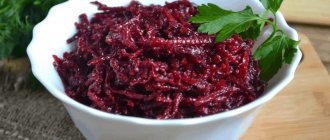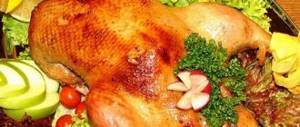How to cook Korean asparagus at home
- White asparagus comes into our kitchen in dried form. Do not purchase ready-made pickled fuja if the composition contains artificial additives, marked with the letter “E”.
- Study the composition of the product. You will see that the asparagus is made from natural soybeans - this is our option. If you find on the packaging that fuju is made from modified raw materials, refuse it - the salad will not be healthy.
- Dry asparagus must be soaked before cooking. Experienced cooks pour boiling water over the product for an hour or two, during which time the strips will swell. Take your time - fill it with cold water, but the holding time will have to be increased to 7-9 hours.
What is Korean asparagus made from?
Asparagus is an unusual product for Russians, so the question of what asparagus is made from for Korean salad is quite natural.
The main ingredient of the dish is asparagus. But the fact is that this product has nothing in common with the vegetable plant of the same name. The correct name of the component is fuju, soy asparagus, the raw material of which is soybean. The manufacturing technology of the product is quite interesting. Soybeans are soaked and milk is extracted. It is then boiled, and the foam formed in the process is skimmed off and dried.
In stores you can easily find fuju in the form of a twisted ribbed sheet of milky white color, used in preparing a variety of delicious dishes at home.
In terms of beneficial properties, soy asparagus is not inferior to the plant variety, which I will discuss below.
Classic Korean homemade asparagus recipe
The most common and easiest recipe for preparing salad at home. start with it, then, having mastered the simplest dish, move on to others.
Take:
- Dry asparagus – 180 gr.
- Garlic – 3-4 cloves.
- Salt – 3 small spoons.
- Sugar – 3 small spoons.
- Soy sauce – 90 ml.
- White onion.
- Sunflower oil for frying ingredients, seasonings for Korean carrots.
How to cook:
- Soak the asparagus (if in cold water, then overnight). Squeeze the workpiece and cut into strips.
- Cut the onion into arbitrary cubes and fry until golden brown.
- Dressing for asparagus: combine the sauce and minced garlic in a bowl. Pour in a little oil, add spices and seasonings. Stir.
- There is one nuance here: the spiciness of the dish can be adjusted by adding Korean seasoning. Taste and add a little bit if you like it spicy.
- Pour the dressing over the fuju, stir, distributing evenly, and leave covered in the cold for 5-6 hours. The longer the salad sits, the tastier it becomes.

Delicious and healthy dishes made from soy asparagus
Fuzhu is used not only as an independent dish, but also as an integral element of many other healthy and tasty recipes. Basically, all dishes that include soy asparagus come from the cuisines of East Asian countries - China, Japan, Korea, India:
- With carrots in Korean;
- Korean asparagus with paprika;
- Diet Caesar with soy asparagus;
- Oriental salad with fuju, seaweed and pickles;
- Autumn salad with pumpkin, pear and fuju.
Korean asparagus recipe with carrots
Korean asparagus with carrots is one of the traditional dishes of oriental cuisine, which is prepared there in every home. To prepare this dish you will need the following ingredients:
- dried semi-finished product - 1 package;
- vegetables: onions and green onions, garlic - 3 - 4 cloves, carrots - 1 kg;
- various seasonings to taste. The main ones are black pepper and coriander;
- soy sauce - 1 tbsp. l.;
- vegetable oil (linseed, olive, sunflower, pumpkin or grape seeds);
- vinegar 70% - 1 - 1.5 tbsp.
First you need to soak the fuju.
- Next, start cooking carrots in Korean. To do this, all the carrots must be chopped on a fine or coarse grater (optional), add ground pepper, salt, 1 - 2 tbsp. l. vinegar and leave to infuse for 15 - 20 minutes.
- After this, finely chop the onion and garlic, fry them in vegetable oil in a frying pan along with coriander, add asparagus.
- Pour soy sauce over the entire mixture, stir, and leave to fry for another 5 - 6 minutes. until fully prepared.
- You need to transfer everything from the frying pan to the carrots and put the salad in the refrigerator.
The dish is usually served cold: this is how its taste properties are most noticeable.
Korean asparagus with paprika
This is another popular recipe for making Korean asparagus with your own hands.
First, you also need to soak the dried product in water for several hours.
Meanwhile, you need to prepare the marinade for soy asparagus:
- The base is soy sauce, in which ground black pepper, salt, 1 - 2 tbsp are mixed. l. fragrant paprika, crushed garlic and finely chopped onion.
- The swollen mass is placed in the resulting marinade and left in the refrigerator for 12 hours.
Important! This recipe is complicated because if you overcook the asparagus in soy sauce, its taste will become cloying and sour.
Korean asparagus and carrot recipe
A wonderful salad that can decorate a holiday meal is popular, and rightfully so. Fuzhu together with Korean carrots is a couple worthy of being combined in one dish.
We take:
- Dried fuju – 200 gr.
- Large red bell pepper.
- Carrots prepared according to a Korean recipe – 300 gr.
- Onion – 2 pcs.
- Soy sauce – 30 ml.
- Garlic cloves – 4-5 pcs.
- Pepper is a mixture of different types.
- Salt.
How to cook asparagus salad in Korean:
- Break asparagus sticks and steam in hot water.
- After an hour, remove and, after draining the liquid, dry with a paper towel.
- Chop the onion into cubes. Cut the bell peppers in the same way. Fry in oil until the onion becomes translucent.
- Add asparagus, finely chopped garlic cloves to the pan, pour in water. Sprinkle with pepper and simmer for 10 minutes.
- Cool and combine with carrots. Season with soy sauce and let steep.

Recipe for “Fuzhu Soy Asparagus”:
First of all, let’s soak our asparagus in warm water for at least an hour. I pour it in this way for at least 4 hours, otherwise it’s still a bit harsh in my opinion. You can even leave it overnight.
Pour some oil into the frying pan - enough to fry the onions properly, plus a little more. Turn on the heat under the frying pan. Chop the onion into cubes and throw into the oil when it warms up.
Then, while the onion is heating up, we decide what to do with the garlic. I crush it and throw it to the onion - let it sauté a little. You can do the same, or you can leave the whole garlic cloves - then you need one and a half times more of them. You can also not fry the garlic, but put the crushed garlic from the garlic press into the cooling dressing. Then you need half as much.
The onion can be slightly browned, or it can be fried until black. Depends on whether you add everything from the pan to the dressing, or just oil. If only oil, then add more oil and fry the onion harder. But I prefer it for a number of reasons, and will even recommend that you add everything as a dressing, not just oil.
While the onions and garlic are browning, crush our coriander in a mortar.
I also grind the pepper in the same mortar
When the onions and garlic are browned, add sesame oil to the frying pan and let it warm up a little, then throw everything from the frying pan into a small bowl or mug. Renegades who put only oil with the smell of garlic and onion in their salad accordingly drain the oil. Throw in the crushed spices. Then add vinegar to this bowl - two tablespoons per pack of asparagus, you can then add more to taste: we are making a salad dressing and not a marinade. This also includes sugar, black pepper, glutamate, salt, soy sauce - the mixture should turn out sweet and salty and extremely rich.
Next, drain the water from the fuju, cut it into 1-6 cm pieces, put it back in the salad bowl, add the dressing there, and mix everything. Leave for at least an hour. Let's eat.
Unlike salads with mayonnaise, Korean salads remain quietly for several days (up to two weeks at temperatures up to 6C, according to the assurances of some manufacturers who prepare salads with a similar recipe - personally, I did not leave Korean salads in the refrigerator for more than 5 days) in the refrigerator directly dressed , they just marinate more and more, and will easily survive the night without a refrigerator (but after that, you shouldn’t set records for keeping salads in the refrigerator).
With almost the same dressing, you can prepare other Korean salads: funcheza (brewed funcheza plus cold bell pepper and cucumber), Korean carrots, Korean carrots with cabbage (not a fan, but I know them). These salads can also be mixed in any proportions, for example, funcheza or asparagus mixed with carrots in Korean is often prepared.
Quick recipe for Korean asparagus and carrot salad
The speed of preparation of any dish is important for housewives. Sometimes there is absolutely no time at all, and relatives ask for asparagus in Korean. A quick salad recipe will help out.
Required:
- Dried asparagus – 250 gr.
- Water – 120 ml.
- Table vinegar (replacement with apple and wine vinegar is acceptable) – 60 ml.
- Carrot.
- Garlic cloves - a couple of pieces.
- Salt – a pinch.
- Ground red pepper - a pinch.
- Sugar – 3 teaspoons.
- Vegetable oil.
How to quickly cook asparagus in Korean:
- Steam the asparagus straws cut into pieces with boiling water for an hour, significantly reducing the swelling time.
- Chop the carrots on a Korean grater, or rub them with coarse shavings on the river.
- Marinade for asparagus: mix salt with red pepper, sugar and garlic pulp in a saucepan. Pour in the vinegar and mix well.
- Place on the stove, turn the heat to low and wait until it boils. Do not let it boil; immediately remove the pan from the stove.
- Place the fuju pieces in a pan, press down with pressure and leave on the table for about an hour. If you don't eat the salad the same day, move the leftovers to the refrigerator.

Asparagus Recipes
The most common recipes for preparing asparagus are:
- asparagus salad;
- Korean asparagus;
- pickled asparagus;
- asparagus soup;
- meat with asparagus;
- asparagus in the oven;
- mushrooms with asparagus;
- asparagus with cream sauce;
- asparagus with potatoes;
- asparagus pie.
Asparagus salad
This salad contains the following ingredients:
- soy asparagus – 250 g;
- sweet pepper – 150 g;
- parsley or cilantro - to taste;
- cucumbers – 150 g;
- spices to taste;
- olive oil – 3 tablespoons;
- rice or apple vinegar – 2 tablespoons;
- soy sauce – 2 tablespoons.
Preparation:
anemia baldness blood pressure gastritis
Asparagus in Korean
To prepare asparagus in Korean you will need:
- soy asparagus – 500 g;
- sunflower oil – 70 g;
- carrots – 1 pc.;
- garlic – 3 cloves;
- onion – 1 piece;
- vinegar – 1 teaspoon;
- ground black pepper – 5 g.
Preparation:
Pickled asparagus
To marinate asparagus you need the following ingredients:
- citric acid – 10 g (half a tablespoon) per 1 liter of water;
- sugar – 30 g (one tablespoon) per 1 liter of water;
- salt – 30 g (one tablespoon) per 1 liter of water;
- asparagus.
Preparation:
Asparagus soup
To make asparagus soup you will need the following ingredients:
- green asparagus – 10 shoots;
- 2 chicken eggs;
- garlic – 2 cloves;
- thin vermicelli – 50 g;
- olive oil – 2 tablespoons;
- salt.
Preparation:
Meat with asparagus
To prepare this dish you will need the following ingredients:
- chicken fillet – 2 pcs;
- asparagus – 150 g;
- cream 35% – 100 ml;
- mustard – 1 tbsp.
- dried parsley – 1 tbsp.
Preparation:
Asparagus in the oven To cook asparagus in the oven you will need the following ingredients:
- white asparagus;
- ham;
- sour cream 20 percent;
- parsley.
Preparation:
Mushrooms with asparagus and bacon under cheese crust
To prepare this dish you will need the following ingredients:
- dry bread - 3 slices;
- onion - half a medium onion;
- garlic – 1 clove;
- olive oil – 2 tablespoons;
- bacon – 100 g;
- mushrooms – 3 pcs. medium size;
- asparagus – 10 shoots;
- cheese – 50 g;
- eggs – 3 pieces;
- milk – 100 ml;
- mustard – 1 teaspoon;
- salt and pepper to taste.
Preparation:
Asparagus with creamy sauce
To prepare asparagus with creamy sauce, you need the following ingredients:
- asparagus – 300 g;
- cream – 200 ml;
- leek - half;
- carrots - half;
- basil - a pinch.
Preparation:
Asparagus with potatoes
To prepare asparagus with potatoes you will need the following ingredients:
- asparagus – 15 shoots;
- potatoes - 4 large tubers;
- soy sauce – 1 tablespoon;
- spices to taste;
- onion – 1 small onion;
- vegetable oil;
- greenery;
- eggs – 2 pieces.
Preparation:
Asparagus Pie
To bake asparagus pie you need the following ingredients:
- asparagus – 500 g;
- dough - any;
- milk – 200 ml;
- cheese – 100 g;
- eggs – 3 pieces;
- smoked chicken breast – 2 pieces.
Preparation:
Korean asparagus with homemade sesame seeds
Korean asparagus salad is delicious on its own. To add a twist, add sesame seeds to the recipe.
- Dry asparagus – 230 gr.
- White and black sesame seeds – 3 tablespoons (take in equal quantities).
- Sugar and salt - a small spoon each.
- Garlic cloves - a couple of pieces.
- Apple cider vinegar – 50 ml.
- A mixture of peppers (required red).
- Oil – 100 ml.
- Carrot.
- Seasonings for Korean carrots.
Preparation:
- Soak the fuju for several hours in cold water. When it swells, divide into pieces.
- Fry the sesame seeds in a dry frying pan so that the seeds fully release their aroma.
- Grate the carrots and add asparagus to it.
- Add all other ingredients, pour in vinegar.
- Bring the oil to a boil in any container and season the dish.
- Cool slightly and place in the refrigerator to infuse. After 5-6 hours, start testing.
Pickled asparagus
- Cooking time: 4.5 hours.
- Number of servings: 2 persons.
- Calorie content of the dish: 250 kcal.
- Purpose: for a snack.
- Cuisine: Korean.
- Difficulty of preparation: easy.
Korean pickled asparagus is a common quick dish that can be found in any Asian food store or supermarket. It’s easy to prepare it yourself, because you only need to soak the semi-finished asparagus product and marinate it. To get a richer taste of the dish after marinating, leave it in the refrigerator for a couple of hours. As a result, the food will be more flavorful.
Ingredients:
- semi-finished asparagus product – 125 g;
- water – 200 ml;
- onion – 1 pc.;
- vegetable oil - half a glass;
- garlic – 2 cloves;
- sugar – 20 g;
- salt – 10 g;
- soy sauce – 40 ml;
- apple cider vinegar – 20 ml;
- coriander - a pinch;
- ground paprika - a pinch;
- ground red pepper – 2 g.
Cooking method:
- Soak the asparagus in water for two hours, squeeze, and cut into small pieces.
- Heat a frying pan over high heat and fry the onion rings. Remove the onion from the pan and flavor the oil with finely grated garlic.
- Place the asparagus on a plate, sprinkle with spices, onions, and salt. Pour in vinegar with sauce and oil.
- Stir, let soak in the marinade, serve after two hours.

Calorie content of salad
Do you like to count calories?
As we have already found out, a Korean dish is prepared from soy asparagus. Unlike vegetable, natural, which has a calorie content of only 15 units per 100 grams, white fuju is more caloric. Soy dried asparagus in 100 grams has 440 kcal, but in dishes the figure is reduced due to the inclusion of other products. Korean asparagus contains 234 kcal. per 100 gr. salad, and this is not too high. Salad can be included in the diet menu if you are watching your weight.

The benefits and harms of asparagus
At the beginning of the article, I told you what asparagus is made from for the Korean version of making salad. But a soy product is unusual for us, so a few words about the benefits and properties of soy asparagus.
Fuju soy product is obtained from the milk of soybeans. This is milk foam, which contains a lot of valuable nutrients.
- Asparagus contains zinc, calcium, magnesium, phosphorus, selenium, and calcium. It will be supplemented with vitamins PP, C, A, and numerous group B. Fiber, polyunsaturated fatty acids, and isoflavones (natural phytoestrogens) will provide health benefits.
- The protein in asparagus is easily digestible. Vegetarians have long noticed this property and use soy products in their diet. Fuzhu is useful for athletes, since soy protein is an excellent building material.
- For women, fuju dishes are beneficial due to the presence of natural estrogen.
- Including Korean-style asparagus in the menu helps with weight loss.
- Helps avoid serious osteoporosis, which is very important for women.
- Korean salad contains a considerable amount of fiber, which helps with constipation.
- Asparagus contains no cholesterol, which reduces the risk of atherosclerosis.
- Fatty acids are endowed with anti-inflammatory effects and antioxidant properties. Protects against heart diseases.
- In addition to its benefits, soy asparagus has some harmful effects on health, especially if consumed uncontrolled. Korean-style asparagus is an incredibly tasty dish, but if you have a history of pancreatic disease, problems with the thyroid gland and gynecological problems in women, you should avoid eating the dish. Be careful when serving salad to children, as estrogens can affect puberty in adolescents.
Possible harm
Despite the healing properties, in the process of organizing the diet, the negative qualities of the product should also be taken into account:
- Soy is not recommended in large quantities for children due to the risk of abnormalities or problems in the development of the reproductive system.
- Excessive intake increases the risk of developing peptic ulcers. This is especially true if a large number of seasonings are used during the cooking process.
- The dish is not recommended for women with a predisposition to estrogen-sensitive malignancies.
- Soy oxalates in the composition are dangerous for the body due to their ability to accumulate in the kidneys.
- The dish contains substances that interfere with the normal functioning of the pancreas and thyroid glands.
- Soy products are considered the strongest allergens. That is why people with allergies should exclude the product from their diet or reduce its intake to a minimum.
The beneficial properties of soy asparagus have been proven by dozens of studies. But if you have a number of diseases, its use is contraindicated:
- problems with the gastrointestinal tract;
- cystitis;
- prostatitis;
- rheumatism.
But it is not necessary to completely exclude the dish from the diet (even if the listed problems are present) - it is enough to reduce it to a minimum.












